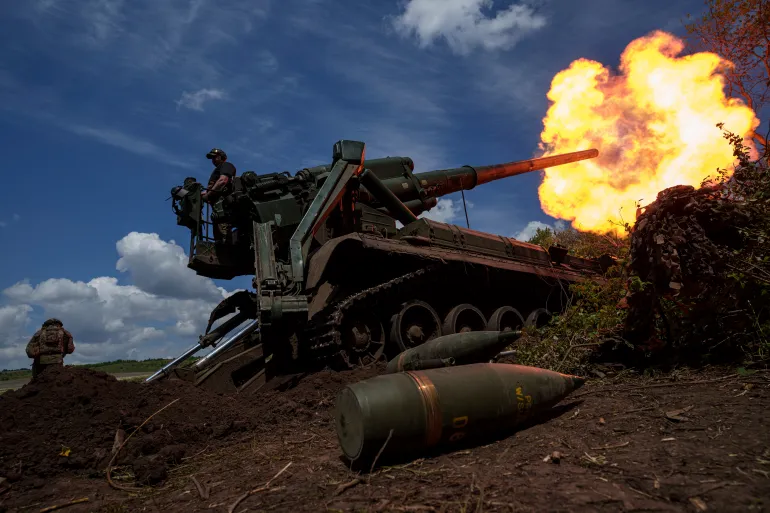Russia suffered political, financial and judicial blows, but Ukraine’s battle on the eastern front remains difficult, too.
Russia has suffered multiple diplomatic and judicial blows during the past week over its war on Ukraine, despite President Vladimir Putin’s high-profile visits to North Korea and Vietnam and Moscow’s claims that it is founding a “Eurasian security architecture that will replace the discredited Euro-Atlantic security arrangements”.
Putin signed a “comprehensive strategic treaty” with North Korean leader Kim Jong Un on June 19, incorporating what he said was a defensive alliance. South Korea’s government condemned the agreement. Its national security adviser, Chang Ho-jin, declared that Seoul would reconsider lifting a ban on arms supplies directly to Ukraine. Until now, South Korea has only sold weapons to Ukraine’s allies.
Chang later added that the type of weapons supplied to Ukraine would depend on Russia’s cooperation with North Korea. Putin said it would be a “grave mistake” if South Korea changed its policy of not supplying belligerents.
Russia also suffered judicial embarrassments. The International Criminal Court at The Hague issued arrest warrants on Tuesday for former Russian Defence Minister Sergei Shoigu and Chief of Military Staff Valery Gerasimov, saying that they bore responsibility for attacks on Ukrainian electricity infrastructure. The court said, “There are reasonable grounds to believe that the alleged strikes were directed against civilian objects,” and that “the expected incidental civilian harm and damage would have been clearly excessive to the anticipated military advantage.”
On the same day, the European Court of Human Rights declared that Russia was in violation of several fundamental human rights in occupied territories. These include abducting people, illegally detaining or torturing them, forcing them to obtain Russian nationality, and numerous other violations.
On the diplomatic front, Russia suffered setbacks in the European Union, which on Tuesday officially opened accession talks with Ukraine and Moldova.
A day earlier, the EU announced a 14th package of sanctions against Russia. Among other things, these sanctions forbid any EU organisation that is part of the “public opinion forming process”, including political parties, think tanks and media, from accepting Russian money or indirect support.
The EU also formally released €1.4bn ($1.5bn) in proceeds from Russian frozen assets to Ukraine. Ninety percent of that money is to be used for military procurements.
Meanwhile, Russia has been unable to make significant headway on the ground in Ukraine, despite opening a new front in the northern Kharkiv region on May 10, designed to pull Ukrainian soldiers away from the eastern front.
That incursion brought its own problems, including prompting the US and Germany to follow Britain and France in allowing Ukraine to use their weapons on Russian soil.
According to figures sourced from the Kharkiv mayor’s office, and quoted in The Washington Post, the partial lifting this month of what used to be a total ban on strikes inside Russia using US equipment has made a difference. Air alerts have so far lasted a total of 62 hours compared with 475 hours in May; there were three strikes on Kharkiv city, compared with 76 in May; and one civilian was killed and seven injured this month compared with 39 killed and 239 injured in May, the Post reported.
The new rules of engagement appeared to have stopped attacks using S-300 air defence missiles and Iranian Shahed drones completely, but glide bombs were still getting through to the city, and many more to the front lines in the northern Kharkiv region.
In fact, Russia successfully experimented with a three-tonne glide bomb for the first time last week. Drone video showed that the blast heavily damaged the Lyptsi medical building on the Kharkiv front, where Russia said fighting was taking place. Until now it has used varying sizes of up to 1.5 tonnes.
Ukraine has been frustrated at being unable to strike the air bases from which Russian bombers carrying glide bombs take off. Two Ukrainian officials told the Post that the US has placed a 100km (62-mile) range limit on the depth to which they may strike targets on Russian soil.
Responding, Pentagon spokesman Major Charlie Dietz, told the Post that, “If Russia is attacking or about to attack from its territory into Ukraine, Ukraine has the ability to hit back against the forces that are hitting it from across the border.” National Security Advisor Jake Sullivan offered an almost identical formulaic response to PBS, saying, “If Russia is attacking or about to attack from its territory into Ukraine, it only makes sense to allow Ukraine to hit back against the forces that are hitting it from across the border.”
Ukraine has used US-provided 300km-range Army Tactical Missiles (ATACMs) since April.
The Institute for the Study of War, a Washington-based think tank, summarised US policy thus: “Ukrainian forces may use [High Mobility Army Rocket Systems-HIIMARS] armed with [Guided Multiple Launch Rocket Systems-GMLRS] to strike Russian forces preparing to or actively attacking Ukraine, but likely may not strike all legitimate Russian military targets in range of Ukrainian HIMARS using GMLRS in Belgorod, Kursk, and Bryansk oblasts.”
Partly because of restrictions on Western weapons and partly because of their high cost, Ukraine embarked this year on a new policy of developing and building as many of its own weapons as possible. During the past week, it used these to strike Russian military and oil facilities with devastating effect.
Advertisement
Ukraine’s Security Service (SBU) said it successfully struck the Tambovnefteprodukt fuel and lubricants warehouse in the Tambov region and the Lukoil-Yugnefteprodukt Enemska oil depot in the Adygea Republic on June 20.
That night, Ukraine launched a massive aerial drone attack on Russian fuel and military facilities, successfully striking a number in occupied Crimea and southern Russia.
Ukraine’s general staff said their forces and Ukraine’s security service (SBU) had struck oil refineries in Afipsky, Ilysky, Krasnodar and Astrakhan. That same night, Ukraine said, its drones struck radio intelligence centres in Zagarbnikiv in Russia’s Bryansk region and occupied Crimea. And Ukrainian drones also struck Shahed-2 and Geran drone storage and training facilities in the Krasnodar region, the staff said.
Further footage emerged on Saturday (June 22), showing secondary explosions coming from what Ukraine said was an air defence training centre in Yeysk, in Krasnodar Krai. And on Sunday the general staff said its air force had struck a motorised rifle regiment command post in Nekhoteevka, in Russia’s Belgorod region, also causing secondary explosions.
On Sunday footage showed smoke and fire coming from an ammunition depot on Olkovatka, in Russia’s Voronezh region. Residents said two drones had struck the facility, and secondary explosions were reported.
Also on Sunday, Ukraine’s national guard confirmed the destruction of two Pantsir-1 air defence systems, south and west of Belgorod city, which also killed their crews.
Ukraine’s military intelligence chief told The Philadelphia Inquirer’s Trudy Rubin that the Russian people would suffer no psychological consequences from waging a war on Ukrainian soil unless they felt the danger of a strike on their own. “I have been advocating this since the very first days of the war, saying openly that so long as the war is contained on our territory, it will not affect Russia,” Kiril Budanov said. “Russia has started to feel it.”
Budanov estimated that “no Armageddon will emerge” on the eastern front, where Russia almost daily manages to creep forward a few yards, though he admitted the situation there was difficult and would likely remain so for the foreseeable future.
Budanov was noncommittal, however, when asked whether Ukrainian troops would succeed in holding a key town on the eastern front where Russia has concentrated much of its war effort. Chasiv Yar sits on high ground, protecting a plain to its west that leads to the main industrial cities of Donetsk. Asked if Ukraine would continue to hold the town, Budanov said, “I will refrain from response.”
Ukraine’s allies moved to shore up its air defences in the past week. Romania and the Netherlands each said they were providing a Patriot air defence system, and the US said it would send all newly produced ammunition for Patriot systems to Ukraine, forcing other recipients to wait. “We’re going to reprioritise the deliveries of these exports so that those missiles rolling off the production line will now be provided to Ukraine,” the White House’s Kirby said.
SOURCE: AL JAZEERA


